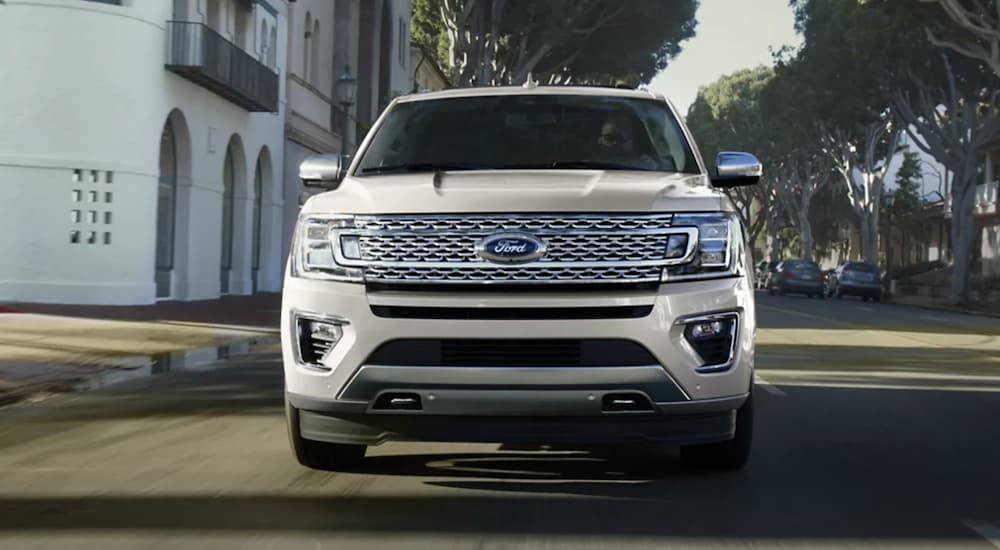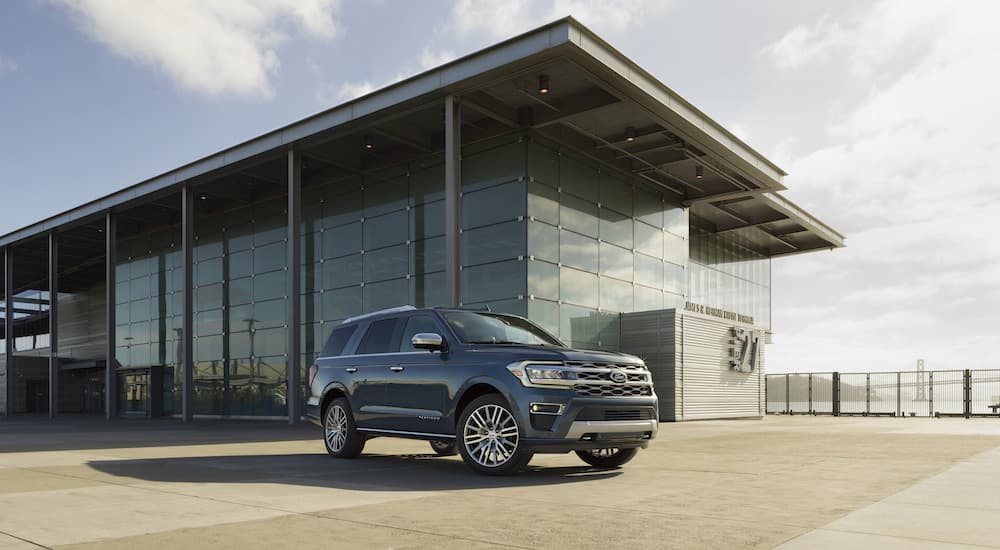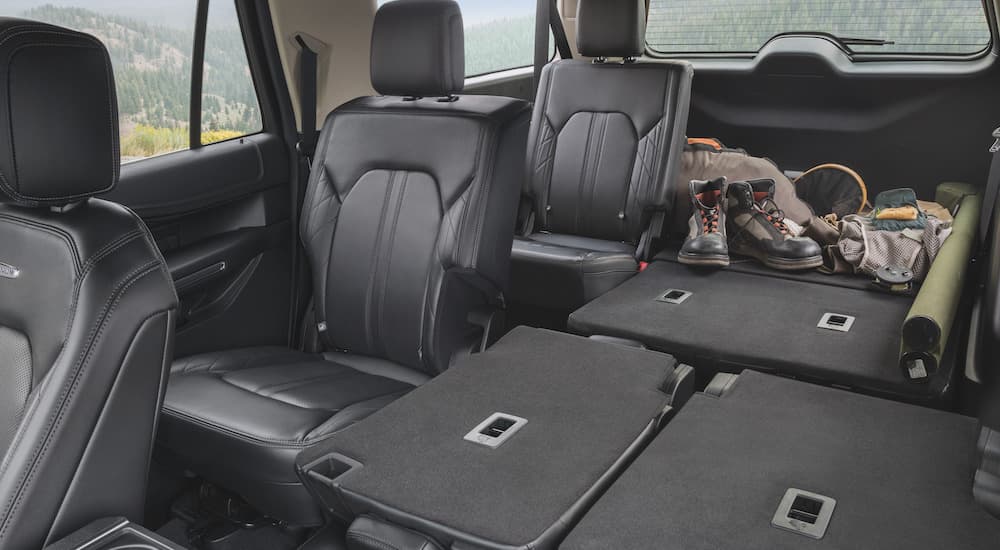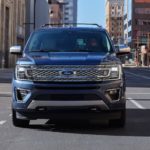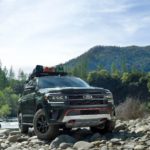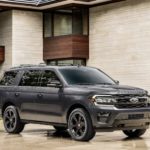Automakers can sometimes be a bit overzealous in describing the abilities of their vehicles, talking about being capable of “anything” when their examples are only the best-case scenarios. Actual experiences with such vehicles might fall short, so it’s always a good idea to look beyond the marketing and see what a particular model truly is capable of. If you’re considering a Ford Expedition for sale, it’s easy to get swept up in the impressive surface-level features of this three-row SUV; to simply take it at face value when Ford advertises the Expedition as “Your Basecamp for Adventure.”
But how well does the Expedition really live up to this assertion? The best way to answer this question is to dig into the specs and different trims available for the Ford Expedition to see what it has to offer. This can be easier said than done because six different trims are available for the standard Expedition, plus four MAX models that are longer overall with more cargo space inside. So let’s dive into the specs of the Expedition—as well as some of its options—to see just how capable it really is and how well it can serve as a “basecamp” for your next adventure.
The Baseline: Standard 2023 Ford Expedition Features
The first thing worth looking at is the fundamental version of the Expedition, which is the starting trim with only the standard features. Of the many trims available, the base is called the XL STX; it features a 3.5L EcoBoost V6 engine that delivers 380 hp and 470 lb-ft of torque, and its ten-speed automatic transmission is quick and responsive. Engine power isn’t the most important thing in an SUV, but with such a large vehicle, you still want to find plenty of muscle to make it fun to drive and strong enough to get off the line. The Expedition comes through in this regard.
Now, as far as its adventurous nature, the standard features for the Ford Expedition are surprisingly good—not surprising for Ford (just look at the Bronco) but surprising for a family-focused SUV like this. It has 9.8 inches of ground clearance, which is a huge advantage for heading off-road; even just dealing with dirt and gravel roads to get to a campsite is easier with this kind of clearance. The standard Expedition has an approach angle of 23.4 degrees, with a 21.5-degree breakover angle and a 22.2-degree departure angle. You’re probably not going to want to take this model onto the Rubicon trail or anything, but it’s still quite impressive and lives up to its name very well.
One of the biggest advantages of a model like this is that its significant size gives you lots of interior space to utilize. Something like a two-door Bronco or Bronco Sport might be better for serious off-roading, but you are limited in how much you can bring along with you. If you want to go camping for a week—or even a long weekend—then having more than 100 cu.ft. of total cargo space inside is ideal for loading up with tents, coolers, sleeping bags, hiking gear, backpacks, and everything else you need. Plus, the Expedition can haul more than 9,000 lbs behind it with its available Heavy-Duty Trailer Towing package, giving you even more options for taking stuff with you.
The MAX Difference
For someone who finds interior cargo space particularly important and wants to bring even more with them, the MAX models are perfect. Essentially, what Ford has done here is extend the wheelbase and overall length of the Expedition; the majority of that interior space is configured for more cargo rather than passengers. Consider these numbers:
Ford Expedition
Overall Length: 210.0 inches
Passenger Space: 171.9 cu.ft.
Rear Cargo Volume: 20.9 cu.ft.
Total Cargo Volume: 104.6 cu.ft.
Ford Expedition MAX
Overall Length: 221.9 inches
Passenger Space: 172.0 cu.ft.
Rear Cargo Volume: 36.0 cu.ft.
Total Cargo Volume: 121.5 cu.ft.
You can see that the biggest differences are in overall length, rear cargo volume, and total cargo space inside. Passenger volume is nearly identical; in other words, choosing a MAX model is all about getting more space for possessions. Whether this is necessary will vary widely from one driver to another and completely depends on how much cargo or gear they expect to load up with regularly. That being said, an Expedition MAX is a great choice for someone who wants to bring along a kayak, paddles, tents, and countless other kinds of gear while still having room inside for a few passengers to ride along toward adventure.
The Ford Expedition Timberline: Full Potential Realized
In looking at the standard features of the Ford Expedition, it’s clear that it can handle some formidable travels, and it certainly excels as a primary vehicle for forging your way to the campsite. For those looking for something truly rugged and ready to hit a few challenging trails, the Expedition Timberline is the way to go. This is the full realization of the Expedition’s potential, and it’s a great pick for serious adventurers.
For starters, the Timberline has a High-Output version of the Expedition’s 3.5L EcoBoost V6 engine that delivers a monstrous 440 hp and 510 lb-ft of torque, giving it a ton of power for handling hills and rough terrain. This thing is a straight-up beast, and I love seeing it in action. Beyond its engine, however, the Timberline also comes with a heavy-duty radiator to help with all the heat it produces, along with Intelligent 4WD (four-wheel drive) and a Terrain Management System. Intelligent 4WD is available on other models but doesn’t always come standard; plus, the Timberline has a Rough Road Suspension with premium off-road shocks.
Proving that the Timberline isn’t all talk, it also has fuel tank underbody protection and skid plates along its underside to protect itself while out on the trail. It has 18-inch wheels, each with a laser-etched Timberline logo; better yet, they’re wrapped in impressive all-terrain tires ready for carving through mud and rocks. Thanks to the off-road engineering of the Timberline, it achieves 10.6 inches of ground clearance, with a 28.5-degree approach angle, a 21.9-degree breakover angle, and a 23.7-degree departure angle—all superior to the standard Expedition and the specs we looked at earlier.
In other words, the Timberline is the model for drivers who really want to be able to go off-road in a large, three-row SUV. That’s certainly a bit of a niche market, but it’s not unreasonable for people with big families to still want to be able to enjoy a weekend outdoors and have an adventure, creating memories together. The fact that we have a vehicle here that can absolutely facilitate such ambition is something to applaud.
Fulfilling the Basecamp Promise
What’s perhaps most impressive is that the Expedition (especially the Timberline trim) has all of these features and the ability to tackle some truly challenging trails while also delivering cutting-edge technology and marvelous conveniences inside. Things like an eight-way power driver’s seat, tri-zone electronic automatic temperature control, and a 12.0-inch infotainment touchscreen are all standard. There are also plenty of options available, as you’d imagine, like nicer seating surfaces, heated and ventilated seats, and even rear-seat entertainment screens with Amazon Fire built in.
This is where the “basecamp” idea really shines: in any kind of adventure, the Expedition can become the hub around which everything else spreads out and sets up. So no matter how rough things get in the Great Outdoors, there’s always a refuge to rely on and a comfortable ride to head home in when the adventure comes to its end.
